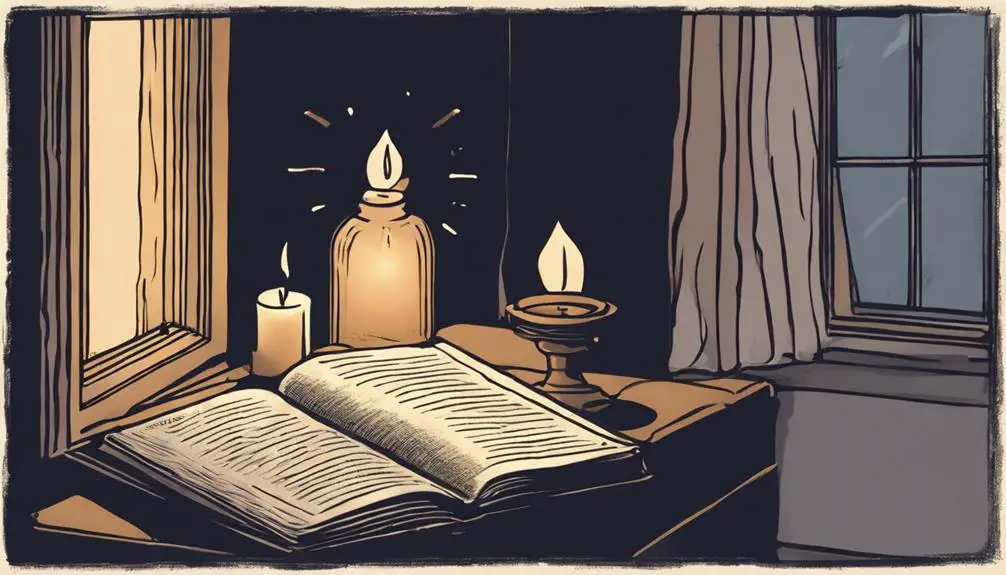Yearning to understand John 8:1-11 more deeply? Explore insightful Bible study questions that shed new light on this profound passage.

John 8 1 11 Bible Study Questions
In the spirit of divine humor, let's ponder this: What if you were in the shoes of the Pharisees in John 8:1-11, ready to cast the first stone?
This intriguing passage presents a powerful lesson on judgment, grace, and forgiveness as demonstrated by Jesus. It's a tale filled with tension, suspense, and profound wisdom. Yet, the nuances of its message often slip through the cracks.
So, while you're sitting there, stone in hand, why not take a moment to explore this narrative further? After all, who knows what revelations might be waiting for you.
Key Takeaways
- Understand the themes of divine grace, mercy, and redemption in John 8:1-11 and their significance in Jesus's teachings.
- Reflect on Jesus's response to the adulteress, emphasizing personal accountability and non-judgment.
- Explore how sin and forgiveness are portrayed in the narrative, underlining the universality of sin and the importance of turning away from it.
- Apply lessons from the text in daily life, focusing on forgiveness, tolerance, personal growth, and transformation.
Contextual Overview of John 8:1-11

To fully grasp the significance of John 8:1-11, you must delve into the historical, cultural, and literary context of this biblical passage. This segment of John's Gospel is famously known as the Pericope Adulterae, depicting Jesus' encounter with a woman caught in adultery.
Historically, this story occurs during the Feast of Tabernacles, a Jewish holiday celebrating God's protection during the Israelites' wilderness journey. Understanding this, you get a sense of the tension between Jesus and the religious leaders, as they were responsible for upholding the law during such a significant event.
Culturally, this narrative highlights the contrasting attitudes towards women and sin during that era. The woman was exposed and condemned publicly, reflecting the patriarchal society's inclination towards shaming women. You must bear in mind this cultural perspective to truly appreciate the audacity of Jesus' response.
Literarily, the passage is loaded with symbolism. The dawn setting, the act of writing on the ground, and Jesus' famous statement, 'He who's without sin, let him be the first to throw a stone at her,' all contribute to the narrative's depth. By examining these aspects, you can better understand and interpret John 8:1-11.
Decoding the Central Themes

Having explored the background of John 8:1-11, let's now decode its central themes, shedding light on the rich tapestry of meaning woven into this passage. The first theme is the divine grace and mercy of Jesus Christ. This passage depicts Jesus as a figure of compassion, who instead of condemning the adulterous woman, pardons her.
The second central theme is the profound message of non-judgment. Jesus's famous line, 'He who's without sin among you, let him be the first to throw a stone at her,' serves as a powerful reminder to all of us to refrain from judging others, knowing that we too aren't without sin.
Lastly, we encounter the theme of transformation and redemption. The adulterous woman, who was seemingly condemned to death, wasn't only spared but given a second chance, with Jesus telling her to go and sin no more. This conveys the transformative power of Christ's teachings and His ability to redeem those who've strayed.
These themes, interwoven in the narrative, provide a deeper understanding of the passage, enriching our interpretation of the text.
Jesus's Response and Its Significance

In studying the significance of Jesus's response, you'll find that His words and actions powerfully underscore His teachings on mercy, non-judgment, and redemption. His response, 'Let any one of you who's without sin be the first to throw a stone at her,' highlights His unique approach to sin. Unlike the Pharisees, who were quick to judge and condemn, Jesus prioritizes understanding and forgiveness.
Jesus's response also underlines His stance on personal accountability. By challenging the accusers to examine their own sinfulness, He shifts the focus from collective punishment to individual responsibility. This reflects the overarching Christian principle of self-examination and repentance.
Furthermore, Jesus's actions, stooping down to write on the ground, present a visual representation of humility and patience. While the text doesn't specify what He wrote, His action creates a stark contrast to the escalating tension, emphasizing His calm demeanor and control over the situation.
Reflections on Sin and Forgiveness

When reflecting on sin and forgiveness in the context of John 8:1-11, you're prompted to consider the profound implications of Jesus's message of mercy and individual accountability. This narrative isn't merely a historical event; it's a testament to the transformational power of forgiveness and the call to self-assessment.
In this passage, Jesus doesn't condemn the woman accused of adultery, instead, he challenges those without sin to cast the first stone. This reveals an important aspect of Jesus's teaching: the universality of sin. It's a stark reminder that you, too, are prone to err, discouraging the harmful tendency to judge others harshly while ignoring personal faults.
Simultaneously, Jesus's words to the woman, 'Go, and sin no more,' underscores the importance of acknowledging and turning away from sin. It's not just about receiving forgiveness; it's also about making a conscious effort to avoid repeating the same mistakes.
Furthermore, the act of forgiveness in this account serves as a model for your own life. It challenges you to forgive others as freely as you've been forgiven. This reflection on sin and forgiveness, therefore, isn't only about comprehending biblical teachings, but about applying these principles practically in daily life.
Personal Applications From the Passage

Drawing from the profound teachings in John 8:1-11, let's explore how you can personally apply these principles in your daily life. This passage provides significant insights into forgiveness, tolerance, and personal transformation.
Firstly, you can adopt a forgiving stance. Like Jesus, who didn't condemn the woman caught in adultery, you can choose to forgive those who've wronged you, irrespective of the gravity of their transgressions. This act of forgiveness not only releases them from their guilt, but also liberates you from the burden of resentment and bitterness.
Secondly, the passage calls for tolerance. When Jesus asked the crowd who was without sin to cast the first stone, he emphasized that no one is devoid of sin. This implies a call for tolerance and understanding toward others' faults. Instead of being quick to judge, try being patient and compassionate.
Lastly, this passage encourages personal transformation. The statement, 'Go and sin no more,' indicates that while forgiveness is available, it shouldn't be taken as license to continue in sin. Use your experiences as stepping stones for growth and transformation.
Through these applications, the teachings in John 8:1-11 can profoundly impact your day-to-day life.
Conclusion
In conclusion, John 8:1-11 challenges us to reconsider how we perceive and react to sin. Jesus's response underscores the importance of humility, compassion, and forgiveness. His message not only calls us to self-examination, but also to extend grace to others.
This passage invites us to embody these values in our lives, reminding us that we're all susceptible to sin yet equally capable of mercy and forgiveness.



Sign up